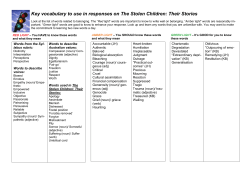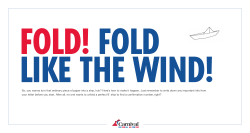
Parts of Speech It is important to understand that
Parts of Speech It is important to understand that every word in a sentence has a job to do, a role in the sentence. Parts of Speech FOLDABLE! This foldable will help you learn the eight parts of speech and their jobs. Take out one piece of notebook paper with the holes intact and follow the instructions so you have a neat foldable that you can use to study. http://www.google.com/imgres?q=vocabulary+foldable&hl http://icanhascheezburger.com/2009/03/30/funny-pictures-origami-gone-wrong/ Foldable Instructions 1. Fold your piece of notebook paper hotdog style to the red line, so that the margin with holes is on your left. 2. Now fold the paper in half hamburger style. Crease it well. 3. Fold in half hamburger style again. Crease well. 4. Fold in half (in the same direction) one more time so when you open it you have eight sections on each side of your paper. 5. Place one hand between the folded hot dog and cut the creases on the right side only. When you are finished, you should have eight flaps that fold out to the right. Nouns/Pronouns Verbs Adjectives Adverbs Conjunctions Articles Prepositions Interjections Close all the flaps so you can write each part of speech on the outside of the right flaps as they show up on the next slide. There are eight parts of speech. Nouns/Pronouns Verbs Adjectives Adverbs Conjunctions Articles Prepositions Interjections A person, place, thing, quality or idea Takes the place of a noun Now write the job, or definition, of each part of speech on the left side of your foldable and an example on the inside of the right flap as the definitions and examples appear on the next slides. (In your example, underline the word that is the part of speech you have just defined.) Noun: person, place, thing or quality (or idea) Person: Ms. Morgan likes to eat spinach. Place: Kealing is the best middle school on earth. Thing: Ms. Roy owns one million geeky board games. Quality: Honesty is a great value to possess. Respect is a must between teachers and students. • Pronoun: takes the place of a noun She likes to eat spinach. Verb: shows action or state of being Action: Ms. Stewart fished all summer. State of being: Ms. Lowe is happy every morning. Adjective: describes a noun The brilliant students balanced the national budget. The strange stretches in yoga class made us look like pretzels. Adverb: describes a verb The sixth grade students worked happily on their poetry assignments. The puppies hungrily ate the spilled cereal. Conjunctions: words that join words, phrases or sentences Hannah and Alex love to cook. You will study Greek, or you will study Pig Latin. I am happy because all my students are respectful to one another. It has been cloudy since the morning. Common conjunctions FANBOYS •For •And •Nor •But •Or •Yet •So Article: there are only three articles – the, a, an (Articles are a subset of adjectives.) The bicycle was not only red, but also shiny. A yellow moon always appears in October. An excellent student, Ms. Cooper passed all her exams the first time. Preposition: a word that shows the relationship between a noun or pronoun and another part of the sentence. The cat was on the table. The dog was under the table. These are some common prepositions: for at with from on under between upon to above in into up toward behind off Interjections: expressive words Wow, Ms. Feldman knocked that ball out of the park! Oh, you really should finish your homework on your own. Ouch, why did you drop that piano on my toe? Ah, now I understand the problem. Copy this sentence on another sheet of paper, skipping lines, and then identify the role/job each word serves. The beautiful queen walked slowly on the cool lawn, and she read aloud a long book about knights and kings.
© Copyright 2025

















